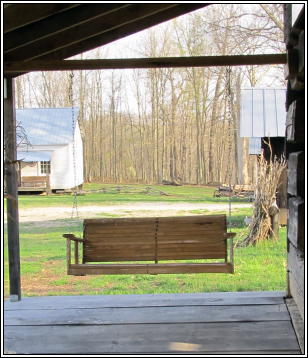
Rick Poling's Porch Stories
By Rick Poling
Executive Director
Calhoun County Committee on Aging
rpoling@cccoa-wv.org
 2011
2011
We celebrate West Virginia Day on June 20th each year, perhaps unmindful of the unique significance and complexity of events that brought West Virginia Day into being.
"Our Haven In The Hills," PART ONE, surveyed events surrounding West Virginia's clever and elegant formation of the "proper and restored legislature of Virginia" and actions taken to form a new Constitution and new State, leading up to Congressional approval of the formation of the State of West Virginia on December 10, 1862, with President Lincoln presenting his signature of consent on New Year's Day of 1863.
That was the successful culmination of events that began two years earlier when delegations from Preston County in November of 1860 and also from Wood County on New Year's Day, 1861, adopted resolutions urging Virginia to resist joining the secession movement of what was then commonly referred to as "The Cotton States" (a movement that was the brain-child of South Carolina Senator John C. Calhoun as a result of the election of Abraham Lincoln, whom had opposed the continuation of slavery during the Presidential campaign of 1860).
Our State's great uncertainties began on December 20, 1860, when, following Calhoun's suggestion, South Carolina seceded from the United States. Georgia, Florida, Alabama, Mississippi, Louisiana and Texas quickly followed suit.
Those seven states formed "The Confederated States of America" and established its capital in Montgomery, Alabama. The eastern and western portions of Virginia immediately became embroiled in disagreement over whether Virginia should likewise secede, with the eastern slave and cotton plantation counties favoring secession and the western counties predominantly opposing it.
On this issue, the western counties' primary concern was not in regard to slavery nor state's rights, but preservation. There was general worry by the western counties' leaders that secession would fully expose the western counties to the wrath of the militia of the Federal government and of two mighty neighboring northern states, Pennsylvania and Ohio. Already severely at odds for many years over issues regarding representation and economic matters, the final lines of division were drawn in the sand between the eastern and western Virginia regions in April of 1861, which is widely considered to be the most tumultuous single month in American history.
On April 12, Confederate troops opened fire on the United States military base at Fort Sumpter, South Carolina. On April 15, President Lincoln mobilized 75,000 troops to "enforce the laws of the United States" against Confederate aggression.
The Virginia Assembly was convened in Richmond to consider secession, and on April 16, representative Henry A. Wise appeared before the body, placed a pistol on the table in front of him, and announced that Virginia troops had seized possession of the Federal Navy Yard in Norfolk and of the Federal Armory in Harper's Ferry.
The following day on April 17, the convention approved Virginia's secession from the United States by vote of 88 for and 55 against (and almost immediately thereafter, the Confederate Capitol was moved from Montgomery to Richmond).
Seldom before had so much changed so quickly.
There are variances among historical reports as to the precise numbers and votes of the delegates from what is now West Virginia, but most accounts indicate that there were 47 total West Virginia delegates, with 32 voting against secession, 11 voting in favor, and 4 abstaining.
Tensions in Richmond were so high that many of the western delegates actually felt it necessary to obtain passports from Virginia's Governor Letcher to return home.
On April 22, a convention in Clarksburg denounced Virginia's secession as "contrary to the expectation of a large majority of the people of the State," and called for all of the counties of Northwestern Virginia to appoint no less than five of their "wisest, best, and disceetest men to meet in Convention on the 13th of May next to consult and determine upon such action as the people of Northwestern Virginia should take in the present fearful emergency."
Thus, the First Wheeling Convention came into being on May 13, 1861, and the events described in PART ONE of "Our Haven In The Hills" subsequently transpired, resulting in President Lincoln's announcement of West Virginia as a new state on New Year's Day, 1863.
But, what happened to result in a six month delay in West Virginia's "official" birth, from New Year's Day until June 20th? Plainly and simply, Lincoln's approval was conditional upon West Virginia's adoption of a Constitutional provision that abolished slavery . . . West Virginia would have to add an amendment to its Constitution to abolish slavery and to become a free state.
And so, once again, the formation of West Virginia became tenuous, with numerous obstacles in the way.
The first obstacle was convening a constitutional convention to debate and generate the necessary Constitutional amendment.
Although the convention that had produced the state's adopted Constitution had wisely been recessed rather than adjourned in case further Constitutional provisions were required for statehood, the chairman, John Hall, was in jail charged with the murder of Lewis Wetzel, editor of the Point Pleasant Register, and all other delegates were either dead or had resigned. So, it took nearly six weeks to organize a recalled Constitutional Convention in Wheeling on February 12th.
Debate then fervently began on the second obstacle, which would be to reach agreement upon anti-slavery constitutional provisions, contained in what is widely known as "The Willey Amendment."
There were a great deal of heated arguments centering on concerns about being "over-run" by former slaves seeking sanctuary in a free state and also upon the deprivation of property of slave-owners and their heirs without compensation (as slaves were considered "property"), but focus eventually became mainly centered upon the prevailing concerns that the region would be militarily destroyed by the North if statehood was not accomplished, and that the economic opportunities and ability to finally have self-determination via a just and fair governing body were all totally dependent upon becoming a State in the Union.
On February 17th, after finally setting aside an extremely contentious provision to establish a fund of $480,000 to compensate slave-owners and their heirs for the freeing of slaves, the convention by vote of 52 to 0 adopted an anti-slavery Constitutional amendment to be voted upon by the public.
Spirited public debate then reached a high pitch, and continued right up to the date of the public's vote on the amendment on March 26, 1863. After the passage of several days to tally and collect the voting results from the various counties, the Wheeling Intelligencer announced the votes on the anti-slavery Constitutional Amendment on April 17th: 27,749 for, and 572 against.
The results were then certified to President Lincoln, whom on April 20, 1863, signed a proclamation that West Virginia was to become a State, to be effective in sixty days. After many twists, turns, and obstacles overcome or avoided over the course of two and a half years, West Virginia was finally officially born on June 20, 1863.
QUOTE OF THE MONTH: "As I would not be a slave, so I would not be a master. This expresses my idea of democracy." Abraham Lincoln
See PORCH READING - Our Haven In The Hills (Part One)
| 


